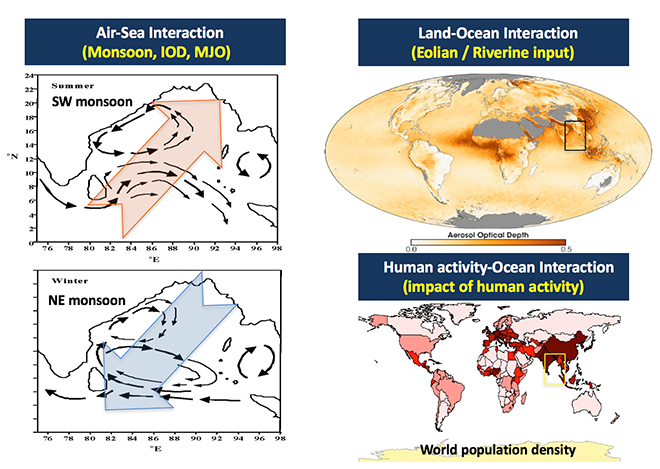The Eastern Indian Ocean including the Bay of Bengal (BoB) and off Sumatra is challenging area or “hot spot” for the study of Atmosphere-Ocean interaction Seasonal monsoon drastically changes physical oceanography and biogeochemical oceanography. Intensity and timing of on/off set of seasonal monsoon might be affected by Indian Ocean Dipole (IOD) event, Madden Julian Oscillation (MJO) and long-term change of water cycle caused by the global warming.
(2) Land-Ocean interaction
During SW monsoon period, river discharge from, mainly, the Ganges and Brahmaputra rivers, increases and a gigantic nutrients and lithogenic materials are supplied to the BoB resulting increase of primary productivity and sinking materials’ flux. On the other hand, supply of fresh water causes the change of physical oceanography, that is stratification. During NE monsoon, NE wind transports terrestrial material to the ocean resulting change in ocean biogeochemistry.
(3) Human-Ocean interaction
Around the Eastern Indian Ocean, nearly one quarter of the world’s population are living. Variable anthropogenic materials such as CO2, nutrient and harmful substances should be supplied to the BoB as riverine input and eolian dust, and should affect the marine biogeochemistry.
In order to verify above issues, satellite data analysis and ocean research are conducted.

Impacts of Indian Ocean Dipole, volcanic eruption, wildfires on ocean productivity
The volcano Kelut of Indonesia exploded on February 13, 2014, produced ash and sulfur dioxide (SO2) clouds. The plume of the SO2, tracked by OMI/Aura, reached the Indian Ocean (Fig. 1b, post-eruption image, 13-18 Feb, 2014), where SO2 is normally low (Fig. 1a, pre-eruption images, 7-12 Feb, 2014).
Observations of pre- (Fig. 1c) and post-eruption (Fig. 1d) phytoplankton biomass (Chl-a) by MODIS/Aqua, showed patches of increased Chl-a (Fig. 1e) following the volcanic eruption. Probably, the cloud plume also contained macro- and micro-nutrients that lead to fertilize Indian Ocean, and thereby promote ocean phytoplankton growth.

Atmospheric nutrient depositions may also come from forest fires. The strongest 1997 Indian Ocean Dipole (IOD), accompanied by upwelling as depicted by low sea surface height anomaly (SSHA, Fig. 2b) and low sea surface temperature (SST, Fig. 2d), also caused forest fire in Indonesia. Upwelling is well known to entrain nutrients into the surface layer. It is also reported however that, aerosol plume (Fig. 2h) from forest fire might deposit micro-nutrient into the Indian Ocean (Abram et al., 2003). Increased of nutrients from both upwelling and forest fire inevitably increased primary productivity (PP, Fig. 2f) in the Indian Ocean.

Related topics
Activity in 2016
Activity in 2015
- Observational cruise in the eastern Indian Ocean
- Possible contribution of aerosols from wildfires in enhancing ocean primary productivity during positive Indian Ocean Dipoles (+IODs)